Marine advisory agent crashes shellfish hurdles
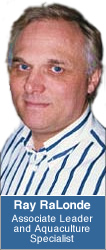 By Doug Schneider, Alaska Sea Grant
By Doug Schneider, Alaska Sea Grant
April 2005
Many people are likely to give up when they run into government bureaucracy and regulation. When Ray RaLonde encounters it, he rolls up his sleeves and sets out to change the system.
RaLonde is an aquaculture specialist with the University of Alaska Fairbanks Sea Grant Marine Advisory Program. His passion is to help grow the state’s fledgling shellfish farming industry. The way he sees it, shellfish farms are the ideal way to expand the state’s coastal economy in a clean, environmentally sustainable way.
“Shellfish farming is one of the cleanest of all coastal industries,” says RaLonde. “In fact, it absolutely relies on a clean environment. It cannot occur in polluted waters. Seeing a shellfish farm actually tells you the environment is healthy.”
Alaska’s coastline has lots of potential places to establish shellfish farms. However, until recently, getting started was complicated by a tangle of state and federal regulations.
“There were so many regulatory hurdles to clear and issues to be resolved before someone could establish an oyster farm,” says RaLonde. “The process was mind-numbing.”
 Frustrated, RaLonde took on the system. The process began with a UA, UAF and Alaska
Sea Grant-funded project to help communities around Prince of Wales Island in Southeast
Alaska develop shellfish farms. At 132 miles long and 45 miles across, Prince of Wales
is one of Alaska’s largest islands. The region is dotted with small, economically
depressed communities in dire need of cash flow. The island’s many coves and bays
were likely candidates for small shellfish farms. And the proximity of the island
to oyster-loving cities such as Anchorage, Seattle and Vancouver make the location
ideal.
Frustrated, RaLonde took on the system. The process began with a UA, UAF and Alaska
Sea Grant-funded project to help communities around Prince of Wales Island in Southeast
Alaska develop shellfish farms. At 132 miles long and 45 miles across, Prince of Wales
is one of Alaska’s largest islands. The region is dotted with small, economically
depressed communities in dire need of cash flow. The island’s many coves and bays
were likely candidates for small shellfish farms. And the proximity of the island
to oyster-loving cities such as Anchorage, Seattle and Vancouver make the location
ideal.
“If there is going to be significant aquaculture expansion in this state, Prince of Wales Island is where it is going to happen,” said RaLonde.
Alaska’s clean, plankton-rich waters and long summers more than make up for the ocean’s frigid temperature which would otherwise slow shellfish growth. As a result, Alaska shellfish quickly grow large. Restaurants and seafood stores pay a premium price for the state’s small harvest from the 21 shellfish farms producing in places like Southeast Alaska, Kachemak Bay and Prince William Sound. In 2003, these farms produced more than a million oysters, as well as mussels, clams and other shellfish worth more than $600,000. There is also tremendous growth potential. Despite in-state production, Alaska still imported more than a million oysters last year.
 “At our current production levels, we cannot meet demand,” says George Overpeck of
the Kachemak Bay Shellfish Growers Cooperative in Homer. “And that’s true of most
of the growers in the state. There is a long list of people who want product. I figure
that by the time we increase production to four times what we have now, I’ll probably
have to actively work to sell the product.”
“At our current production levels, we cannot meet demand,” says George Overpeck of
the Kachemak Bay Shellfish Growers Cooperative in Homer. “And that’s true of most
of the growers in the state. There is a long list of people who want product. I figure
that by the time we increase production to four times what we have now, I’ll probably
have to actively work to sell the product.”
For communities struggling because of lost commercial fishing and timber harvesting jobs, shellfish aquaculture is viewed as a way to diversify their economic base.
“The average 10-acre oyster farm produces about $17,000 to $20,000 worth of oysters per acre each year,” said RaLonde. “A 10-acre farm should gross about $170,000 or more each year. So this has the potential to provide a sustainable, environmentally friendly livelihood for people.”
Under the old system, getting a farm up and running took years. What if RaLonde could help an entire region of the state at once? His strategy: work with interested Prince of Wales Island communities to gather all of the information needed by regulators, and convince the state to pre-approve large tracts of tidelands for aquaculture.
“The key was to help communities that wanted aquaculture and work with them to enlist local support and identify sites,” RaLonde said.
RaLonde visited communities across Prince of Wales Island and found that Thorne Bay, Kasaan and Naukati were interested in shellfish aquaculture.
Art King represents Naukati West, a homeowners association of 137 people who live in the small former logging camp. “We were just loggers here, and we wanted to change our economy,” said King. “Ray came here and worked with us to streamline the aquaculture permit process (PDF 34K). His expertise has been an enormous help to us.”
 With money from Alaska Sea Grant, the University of Alaska President’s Natural Resources Fund and the Alaska Cooperative Extension Service, RaLonde and his colleagues spent three months in 2001 surveying 900 square miles
of bays, estuaries and beaches near interested communities. Some places were off limits
because they had other uses, such as for recreation or subsistence. More time went
into gathering information on existing uses by people and wildlife. In the end, enough
information was gathered to propose that some 1,300 acres of the island’s tidelands
be set aside for aquaculture.
With money from Alaska Sea Grant, the University of Alaska President’s Natural Resources Fund and the Alaska Cooperative Extension Service, RaLonde and his colleagues spent three months in 2001 surveying 900 square miles
of bays, estuaries and beaches near interested communities. Some places were off limits
because they had other uses, such as for recreation or subsistence. More time went
into gathering information on existing uses by people and wildlife. In the end, enough
information was gathered to propose that some 1,300 acres of the island’s tidelands
be set aside for aquaculture.
What happened next surprised even RaLonde. In August 2002, the Alaska Legislature invited RaLonde to give a presentation about his efforts. RaLonde brought with him the state shellfish hatchery manager and two oyster growers. They explained the project and the progress made in communities like Naukati. “We blew their socks off,” said an elated RaLonde.
Soon after, the Alaska Legislature introduced House Bill 208 (PDF 72K), which required the Alaska Department of Fish and Game and the Alaska Department of Natural Resources to approve 90 aquaculture sites within a year. In 2003, the Alaska Legislature provided $470,000 for additional site selection studies and state agency support. Another $900,000 grant was awarded to the Alaska Shellfish Growers Association for eight aquaculture infrastructure projects. The grant was used to make improvements to the Qutekcak Shellfish Hatchery in Seward, as well as to construct a shellfish grading and distribution center in Homer, and to provide smaller grants to individual growers to improve their operations. In late 2003, the state approved 1,346 acres of tidelands for public lease around Prince of Wales Island, as well as near Ketchikan and Wrangell.
“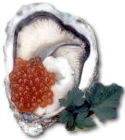 That’s enough water for 158 farms, so we were very happy,” RaLonde said. “Access to
tidelands is an essential element to expand shellfish farming in Alaska, but we still
have a long way to go to grow this industry. The University of Alaska Sea Grant Marine
Advisory Program remains committed to the vision of a vital shellfish farming industry
for Alaska.”
That’s enough water for 158 farms, so we were very happy,” RaLonde said. “Access to
tidelands is an essential element to expand shellfish farming in Alaska, but we still
have a long way to go to grow this industry. The University of Alaska Sea Grant Marine
Advisory Program remains committed to the vision of a vital shellfish farming industry
for Alaska.”
In Naukati, Art King said the first crop of oysters from the 16 new farms in the region will be shipped to waiting markets next year.
“We are starting to blossom again here,” said King. “Ray has helped us and this industry enormously.”
For more information, please contact:
- Raymond RaLonde, aquaculture specialist, Alaska Sea Grant Marine Advisory Program at afrlr@uaa.alaska.edu or (907) 274-9697
Useful links:
- ADF&G Commercial Fisheries: Mariculture and Aquatic Farming
- Alaska Department of Commerce: Mariculture in Alaska
- Online Guide: Starting a Mariculture Business in Alaska
- Alaska Department of Natural Resources Aquatic Farming Program
- Alaskan Shellfish Growers Association
- Alaska Sea Grant Program
- Aquaculture Publications & Videos Catalog
- Marine Advisory Program
- Marine Advisory Program Aquaculture
- "Alaska warming up to shellfish farming" (PDF 329K), Intrafish newspaper, United Kingdom, March 2005
Ray RaLonde photo courtesy of Alaska Sea Grant Marine Advisory Program.
Oyster photo courtesy of Alaskan Shellfish Growers Association.

RaLonde and residents of Pelican in Southeast Alaska sort through samples of clams
collected earlier on the beach. The Pelican area has great potential for clam aquaculture.
Photo courtesy of Alaska Sea Grant Marine Advisory Program.
![]() Market Opportunities for Shellfish Aquaculture
Market Opportunities for Shellfish Aquaculture
Slide show presentation (Javascript)
Slide show handout (PDF 1.43M)
Learn about the projected shellfish trends for Japan, China, Europe, U.S.A. and world
markets. Presentation by Howard M. Johnson.
 A handful of oyster spat are the right size for shipment to a shellfish farmer. Spat
are delivered to the nursery from a hatchery when only 3 mm in diameter. Once grown
to 12-25 mm, they are ready for purchase by farmers to grow to maturity. About two
months at the nursery saves a year of growth at the farm. Photo by Ray RaLonde.
A handful of oyster spat are the right size for shipment to a shellfish farmer. Spat
are delivered to the nursery from a hatchery when only 3 mm in diameter. Once grown
to 12-25 mm, they are ready for purchase by farmers to grow to maturity. About two
months at the nursery saves a year of growth at the farm. Photo by Ray RaLonde.
 Workers plant clam seed at low tide in nursery plots during the middle of the night
on Annette Island. Photo by Ray RaLonde.
Workers plant clam seed at low tide in nursery plots during the middle of the night
on Annette Island. Photo by Ray RaLonde.
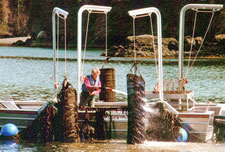 Bob Hartley sprays seaweed and algae off lantern nets full of oysters in Peterson
Bay, an embayment within Kachemak Bay. It is important to keep fouling under control
to maximize growth of the oysters. Photo by Ray RaLonde.
Bob Hartley sprays seaweed and algae off lantern nets full of oysters in Peterson
Bay, an embayment within Kachemak Bay. It is important to keep fouling under control
to maximize growth of the oysters. Photo by Ray RaLonde.
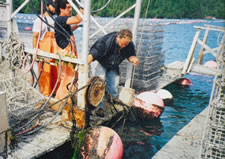
Oysters are cultured in trays at Jim Aguiar's farm near Cordova in Prince William
Sound. Trays with wire cages are used in Prince William Sound to keep sea otters from
eating the oysters. Otters can easily get into the standard lantern net used in other
locations. Photo by Ray RaLonde.
 Ray RaLonde and Jeff Moran, fisheries director for the Annette Island Department
of Natural Resources, sort through trays of oysters at the startup farm in summer
2003. Photo by Dustin Winters.
Ray RaLonde and Jeff Moran, fisheries director for the Annette Island Department
of Natural Resources, sort through trays of oysters at the startup farm in summer
2003. Photo by Dustin Winters.
 Sorting oysters after harvesting is an important step in the marketing process. Photo
by David Sczawinski.
Sorting oysters after harvesting is an important step in the marketing process. Photo
by David Sczawinski.
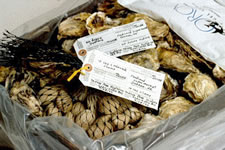 A mixed box of clams and oysters are packaged for shpping. Shellfish farmers nationwide
are required to ship all shellfish with FDA approved shipping tags which stay with
them all the way to the retailer. At a seafood counter, you can ask where the shellfish
came from and the date they were harvested. Photo by Roger Painter.
A mixed box of clams and oysters are packaged for shpping. Shellfish farmers nationwide
are required to ship all shellfish with FDA approved shipping tags which stay with
them all the way to the retailer. At a seafood counter, you can ask where the shellfish
came from and the date they were harvested. Photo by Roger Painter.
![]() Mariculture in Alaska
Mariculture in Alaska
Slide show presentation (Javascript)
Slide show handout (PDF 405K)
Notes on choosing a good site, the application process and the production potential
for Alaska farm sites. Presentation by Guyla McGrady.


